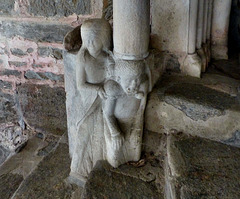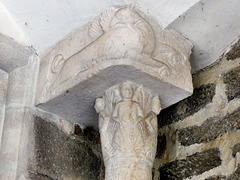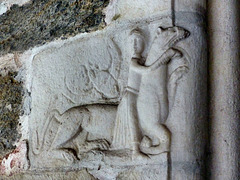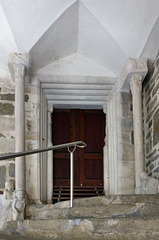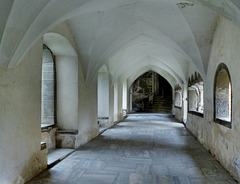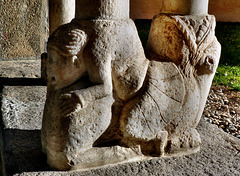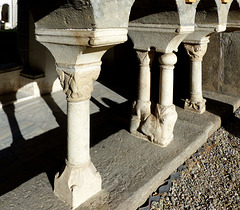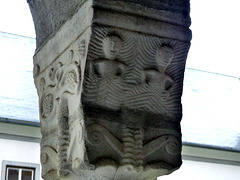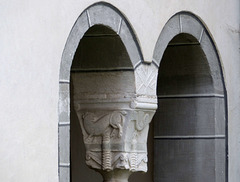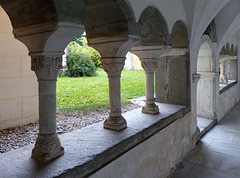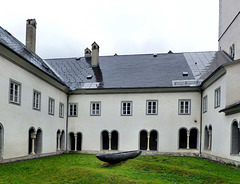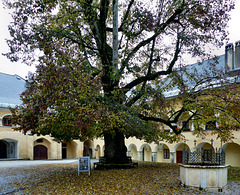Martin M. Miles' photos
Millstatt am See - Stift Millstatt
| |
|
Stift Millstatt ("Millstatt Abbey") was founded by the Aribo II and Boto, members of Aribonids, a noble, Bavarian family, around 1070.
Run by Benedictine monks and protected by Papal deeds Stift Millstatt prospered in the early years and a nunnery was added.
Within the 13th century, the decay began. As the abbey had secular Church Vogts, it suffered strongly under the political powergames of that timne and finaly ended 1456 under the House of Habsburg. At that time only 10 monks still lived here.
Emperor Frederick III reached a papal bull in 1469, so that the military order of the Knights of Saint George took over Stift Millstatt in order to fight the invading troops of the Ottoman Empire.
The order now had to cope with the debts left by the Benedictines and the redevelopment of the neglected premises. While the knights were engaged with the fortification of the monastery, they failed to protect the region. Millstatt was heavily devastated by the Turks in 1478, followed by Hungarian troops in 1487. As the power of the knightly order declined, unrests and revolts arose among the peasants.
As the new Protestant belief spread in the area the monastery vested the Society of Jesus ("Jesuits") in 1598 to support the Counter-Reformation.
The monks were disliked by the population for their stern measures. In 1737 the displeasure culminated in open revolt, when peasants ganged up and stormed the monastery. The rule of the Jesuits ended, when the order was suppressed by Pope Clement XIV in 1773. The monks had to leave Millstatt.
Today the former abbey-church serves the parish, while the other buildings belong to the Austrian state and host the "Österreichische Bundesforste" (Austrian State Forestry Commission).
The church underwent numerous alterations over the centuries. It did not only suffer from fires, but as well from earthquakes. A strong quake in 1690 heavily damaged the western facade.
The side portal of the former abby church is in the northeastern corner of the cloister. This is from where the monks entered the church. The portal was "remodeled" around 1500, using Romanesque sculptures, that probably were created 1150-1200 for different places.
On both sides of the portal are very similar sculptures. Properly dressed ladies hold ugly men. Here the man is in chains. This may stand for the Christianity - and Heathenism.
The chained person reminds me on sculptures in Oloron-Sainte-Marie and Morlaàs (Southern France).
Millstatt am See - Stift Millstatt
| |
|
|
|
Stift Millstatt ("Millstatt Abbey") was founded by the Aribo II and Boto, members of Aribonids, a noble, Bavarian family, around 1070.
Run by Benedictine monks and protected by Papal deeds Stift Millstatt prospered in the early years and a nunnery was added.
Within the 13th century, the decay began. As the abbey had secular Church Vogts, it suffered strongly under the political powergames of that timne and finaly ended 1456 under the House of Habsburg. At that time only 10 monks still lived here.
Emperor Frederick III reached a papal bull in 1469, so that the military order of the Knights of Saint George took over Stift Millstatt in order to fight the invading troops of the Ottoman Empire.
The order now had to cope with the debts left by the Benedictines and the redevelopment of the neglected premises. While the knights were engaged with the fortification of the monastery, they failed to protect the region. Millstatt was heavily devastated by the Turks in 1478, followed by Hungarian troops in 1487. As the power of the knightly order declined, unrests and revolts arose among the peasants.
As the new Protestant belief spread in the area the monastery vested the Society of Jesus ("Jesuits") in 1598 to support the Counter-Reformation.
The monks were disliked by the population for their stern measures. In 1737 the displeasure culminated in open revolt, when peasants ganged up and stormed the monastery. The rule of the Jesuits ended, when the order was suppressed by Pope Clement XIV in 1773. The monks had to leave Millstatt.
Today the former abbey-church serves the parish, while the other buildings belong to the Austrian state and host the "Österreichische Bundesforste" (Austrian State Forestry Commission).
The church underwent numerous alterations over the centuries. It did not only suffer from fires, but as well from earthquakes. A strong quake in 1690 heavily damaged the western facade.
The side portal of the former abby church is in the northeastern corner of the cloister. This is from where the monks entered the church. The portal was "remodeled" around 1500, using Romanesque sculptures, that probably were created 1150-1200 for different places.
A devouring monster over a capital with a group of mermaids. The poor victim in the monster´s mouth holds a kind of tool..
Millstatt am See - Stift Millstatt
| |
|
Stift Millstatt ("Millstatt Abbey") was founded by the Aribo II and Boto, members of Aribonids, a noble, Bavarian family, around 1070.
Run by Benedictine monks and protected by Papal deeds Stift Millstatt prospered in the early years and a nunnery was added.
Within the 13th century, the decay began. As the abbey had secular Church Vogts, it suffered strongly under the political powergames of that timne and finaly ended 1456 under the House of Habsburg. At that time only 10 monks still lived here.
Emperor Frederick III reached a papal bull in 1469, so that the military order of the Knights of Saint George took over Stift Millstatt in order to fight the invading troops of the Ottoman Empire.
The order now had to cope with the debts left by the Benedictines and the redevelopment of the neglected premises. While the knights were engaged with the fortification of the monastery, they failed to protect the region. Millstatt was heavily devastated by the Turks in 1478, followed by Hungarian troops in 1487. As the power of the knightly order declined, unrests and revolts arose among the peasants.
As the new Protestant belief spread in the area the monastery vested the Society of Jesus ("Jesuits") in 1598 to support the Counter-Reformation.
The monks were disliked by the population for their stern measures. In 1737 the displeasure culminated in open revolt, when peasants ganged up and stormed the monastery. The rule of the Jesuits ended, when the order was suppressed by Pope Clement XIV in 1773. The monks had to leave Millstatt.
Today the former abbey-church serves the parish, while the other buildings belong to the Austrian state and host the "Österreichische Bundesforste" (Austrian State Forestry Commission).
The church underwent numerous alterations over the centuries. It did not only suffer from fires, but as well from earthquakes. A strong quake in 1690 heavily damaged the western facade.
The side portal of the former abby church is in the northeastern corner of the cloister. This is from where the monks entered the church. The portal was "remodeled" around 1500, using Romanesque sculptures, that probably were created 1150-1200 for different places. Here - over the capital - lurks a huge griffon.
Millstatt am See - Stift Millstatt
| |
|
|
|
Stift Millstatt ("Millstatt Abbey") was founded by the Aribo II and Boto, members of Aribonids, a noble, Bavarian family, around 1070.
Run by Benedictine monks and protected by Papal deeds Stift Millstatt prospered in the early years and a nunnery was added.
Within the 13th century, the decay began. As the abbey had secular Church Vogts, it suffered strongly under the political powergames of that timne and finaly ended 1456 under the House of Habsburg. At that time only 10 monks still lived here.
Emperor Frederick III reached a papal bull in 1469, so that the military order of the Knights of Saint George took over Stift Millstatt in order to fight the invading troops of the Ottoman Empire.
The order now had to cope with the debts left by the Benedictines and the redevelopment of the neglected premises. While the knights were engaged with the fortification of the monastery, they failed to protect the region. Millstatt was heavily devastated by the Turks in 1478, followed by Hungarian troops in 1487. As the power of the knightly order declined, unrests and revolts arose among the peasants.
As the new Protestant belief spread in the area the monastery vested the Society of Jesus ("Jesuits") in 1598 to support the Counter-Reformation.
The monks were disliked by the population for their stern measures. In 1737 the displeasure culminated in open revolt, when peasants ganged up and stormed the monastery. The rule of the Jesuits ended, when the order was suppressed by Pope Clement XIV in 1773. The monks had to leave Millstatt.
Today the former abbey-church serves the parish, while the other buildings belong to the Austrian state and host the "Österreichische Bundesforste" (Austrian State Forestry Commission).
The church underwent numerous alterations over the centuries. It did not only suffer from fires, but as well from earthquakes. A strong quake in 1690 heavily damaged the western facade.
The side portal of the former abby church is in the northeastern corner of the cloister. This is from where the monks entered the church. The portal was "remodeled" around 1500, using Romanesque sculptures, that probably were created 1150-1200 for different places. Here is a tiny Samson fighting a giant lion.
Millstatt am See - Stift Millstatt
| |
|
|
Stift Millstatt ("Millstatt Abbey") was founded by the Aribo II and Boto, members of Aribonids, a noble, Bavarian family, around 1070.
Run by Benedictine monks and protected by Papal deeds Stift Millstatt prospered in the early years and a nunnery was added.
Within the 13th century, the decay began. As the abbey had secular Church Vogts, it suffered strongly under the political powergames of that timne and finaly ended 1456 under the House of Habsburg. At that time only 10 monks still lived here.
Emperor Frederick III reached a papal bull in 1469, so that the military order of the Knights of Saint George took over Stift Millstatt in order to fight the invading troops of the Ottoman Empire.
The order now had to cope with the debts left by the Benedictines and the redevelopment of the neglected premises. While the knights were engaged with the fortification of the monastery, they failed to protect the region. Millstatt was heavily devastated by the Turks in 1478, followed by Hungarian troops in 1487. As the power of the knightly order declined, unrests and revolts arose among the peasants.
As the new Protestant belief spread in the area the monastery vested the Society of Jesus ("Jesuits") in 1598 to support the Counter-Reformation.
The monks were disliked by the population for their stern measures. In 1737 the displeasure culminated in open revolt, when peasants ganged up and stormed the monastery. The rule of the Jesuits ended, when the order was suppressed by Pope Clement XIV in 1773. The monks had to leave Millstatt.
Today the former abbey-church serves the parish, while the other buildings belong to the Austrian state and host the "Österreichische Bundesforste" (Austrian State Forestry Commission).
The church underwent numerous alterations over the centuries. It did not only suffer from fires, but as well from earthquakes. A strong quake in 1690 heavily damaged the western facade.
The side portal of the former abby church is in the northeastern corner of the cloister. This is from where the monks entered the church. The portal was "remodeled" around 1500, using Romanesque sculptures, that probably were created 1150-1200 for different places.
Millstatt am See - Stift Millstatt
| |
|
|
|
Stift Millstatt ("Millstatt Abbey") was founded by the Aribo II and Boto, members of Aribonids, a noble, Bavarian family, around 1070.
Run by Benedictine monks and protected by Papal deeds Stift Millstatt prospered in the early years and a nunnery was added.
Within the 13th century, the decay began. As the abbey had secular Church Vogts, it suffered strongly under the political powergames of that timne and finaly ended 1456 under the House of Habsburg. At that time only 10 monks still lived here.
Emperor Frederick III reached a papal bull in 1469, so that the military order of the Knights of Saint George took over Stift Millstatt in order to fight the invading troops of the Ottoman Empire.
The order now had to cope with the debts left by the Benedictines and the redevelopment of the neglected premises. While the knights were engaged with the fortification of the monastery, they failed to protect the region. Millstatt was heavily devastated by the Turks in 1478, followed by Hungarian troops in 1487. As the power of the knightly order declined, unrests and revolts arose among the peasants.
As the new Protestant belief spread in the area the monastery vested the Society of Jesus ("Jesuits") in 1598 to support the Counter-Reformation.
The monks were disliked by the population for their stern measures. In 1737 the displeasure culminated in open revolt, when peasants ganged up and stormed the monastery. The rule of the Jesuits ended, when the order was suppressed by Pope Clement XIV in 1773. The monks had to leave Millstatt.
Today the former abbey-church serves the parish, while the other buildings belong to the Austrian state and host the "Österreichische Bundesforste" (Austrian State Forestry Commission).
The church underwent numerous alterations over the centuries. It did not only suffer from fires, but as well from earthquakes. A strong quake in 1690 heavily damaged the western facade.
The side portal of the former abby church is in the northeastern corner of the cloister. This is from where the monks entered the church. The portal was "remodeled" around 1500, using Romanesque sculptures, that probably were created 1150-1200 for different places.
Millstatt am See - Stift Millstatt
| |
|
Stift Millstatt ("Millstatt Abbey") was founded by the Aribo II and Boto, members of Aribonids, a noble, Bavarian family, around 1070.
Run by Benedictine monks and protected by Papal deeds Stift Millstatt prospered in the early years and a nunnery was added.
Within the 13th century, the decay began. As the abbey had secular Church Vogts, it suffered strongly under the political powergames of that timne and finaly ended 1456 under the House of Habsburg. At that time only 10 monks still lived here.
Emperor Frederick III reached a papal bull in 1469, so that the military order of the Knights of Saint George took over Stift Millstatt in order to fight the invading troops of the Ottoman Empire.
The order now had to cope with the debts left by the Benedictines and the redevelopment of the neglected premises. While the knights were engaged with the fortification of the monastery, they failed to protect the region. Millstatt was heavily devastated by the Turks in 1478, followed by Hungarian troops in 1487. As the power of the knightly order declined, unrests and revolts arose among the peasants.
As the new Protestant belief spread in the area the monastery vested the Society of Jesus ("Jesuits") in 1598 to support the Counter-Reformation.
The monks were disliked by the population for their stern measures. In 1737 the displeasure culminated in open revolt, when peasants ganged up and stormed the monastery. The rule of the Jesuits ended, when the order was suppressed by Pope Clement XIV in 1773. The monks had to leave Millstatt.
Today the former abbey-church serves the parish, while the other buildings belong to the Austrian state and host the "Österreichische Bundesforste" (Austrian State Forestry Commission).
The church underwent numerous alterations over the centuries. It did not only suffer from fires, but as well from earthquakes. A strong quake in 1690 heavily damaged the western facade.
The old cloister has some very interesting capitals.
The previous uploads give an overview, here are more details. The lion is a so called "pillar-eater" and the person on the lion´s back is a kind of atlas.
Millstatt am See - Stift Millstatt
| |
|
|
Stift Millstatt ("Millstatt Abbey") was founded by the Aribo II and Boto, members of Aribonids, a noble, Bavarian family, around 1070.
Run by Benedictine monks and protected by Papal deeds Stift Millstatt prospered in the early years and a nunnery was added.
Within the 13th century, the decay began. As the abbey had secular Church Vogts, it suffered strongly under the political powergames of that timne and finaly ended 1456 under the House of Habsburg. At that time only 10 monks still lived here.
Emperor Frederick III reached a papal bull in 1469, so that the military order of the Knights of Saint George took over Stift Millstatt in order to fight the invading troops of the Ottoman Empire.
The order now had to cope with the debts left by the Benedictines and the redevelopment of the neglected premises. While the knights were engaged with the fortification of the monastery, they failed to protect the region. Millstatt was heavily devastated by the Turks in 1478, followed by Hungarian troops in 1487. As the power of the knightly order declined, unrests and revolts arose among the peasants.
As the new Protestant belief spread in the area the monastery vested the Society of Jesus ("Jesuits") in 1598 to support the Counter-Reformation.
The monks were disliked by the population for their stern measures. In 1737 the displeasure culminated in open revolt, when peasants ganged up and stormed the monastery. The rule of the Jesuits ended, when the order was suppressed by Pope Clement XIV in 1773. The monks had to leave Millstatt.
Today the former abbey-church serves the parish, while the other buildings belong to the Austrian state and host the "Österreichische Bundesforste" (Austrian State Forestry Commission).
The church underwent numerous alterations over the centuries. It did not only suffer from fires, but as well from earthquakes. A strong quake in 1690 heavily damaged the western facade.
The old cloister has some very interesting capitals.
The previous uploads give an overview, here are more details. The lion is a so called "pillar-eater" and the person on the lion´s back is a kind of atlas.
Millstatt am See - Stift Millstatt
| |
|
|
Stift Millstatt ("Millstatt Abbey") was founded by the Aribo II and Boto, members of Aribonids, a noble, Bavarian family, around 1070.
Run by Benedictine monks and protected by Papal deeds Stift Millstatt prospered in the early years and a nunnery was added.
Within the 13th century, the decay began. As the abbey had secular Church Vogts, it suffered strongly under the political powergames of that timne and finaly ended 1456 under the House of Habsburg. At that time only 10 monks still lived here.
Emperor Frederick III reached a papal bull in 1469, so that the military order of the Knights of Saint George took over Stift Millstatt in order to fight the invading troops of the Ottoman Empire.
The order now had to cope with the debts left by the Benedictines and the redevelopment of the neglected premises. While the knights were engaged with the fortification of the monastery, they failed to protect the region. Millstatt was heavily devastated by the Turks in 1478, followed by Hungarian troops in 1487. As the power of the knightly order declined, unrests and revolts arose among the peasants.
As the new Protestant belief spread in the area the monastery vested the Society of Jesus ("Jesuits") in 1598 to support the Counter-Reformation.
The monks were disliked by the population for their stern measures. In 1737 the displeasure culminated in open revolt, when peasants ganged up and stormed the monastery. The rule of the Jesuits ended, when the order was suppressed by Pope Clement XIV in 1773. The monks had to leave Millstatt.
Today the former abbey-church serves the parish, while the other buildings belong to the Austrian state and host the "Österreichische Bundesforste" (Austrian State Forestry Commission).
The church underwent numerous alterations over the centuries. It did not only suffer from fires, but as well from earthquakes. A strong quake in 1690 heavily damaged the western facade.
The old cloister has some very interesting capitals.
These are the same pillars as seen (from the other side) on the previous upload. The lion (right) - and a person (left) riding on the lion´s back. Actually the person is not "riding" - as he is facing backwards.
Millstatt am See - Stift Millstatt
| |
|
|
|
Stift Millstatt ("Millstatt Abbey") was founded by the Aribo II and Boto, members of Aribonids, a noble, Bavarian family, around 1070.
Run by Benedictine monks and protected by Papal deeds Stift Millstatt prospered in the early years and a nunnery was added.
Within the 13th century, the decay began. As the abbey had secular Church Vogts, it suffered strongly under the political powergames of that timne and finaly ended 1456 under the House of Habsburg. At that time only 10 monks still lived here.
Emperor Frederick III reached a papal bull in 1469, so that the military order of the Knights of Saint George took over Stift Millstatt in order to fight the invading troops of the Ottoman Empire.
The order now had to cope with the debts left by the Benedictines and the redevelopment of the neglected premises. While the knights were engaged with the fortification of the monastery, they failed to protect the region. Millstatt was heavily devastated by the Turks in 1478, followed by Hungarian troops in 1487. As the power of the knightly order declined, unrests and revolts arose among the peasants.
As the new Protestant belief spread in the area the monastery vested the Society of Jesus ("Jesuits") in 1598 to support the Counter-Reformation.
The monks were disliked by the population for their stern measures. In 1737 the displeasure culminated in open revolt, when peasants ganged up and stormed the monastery. The rule of the Jesuits ended, when the order was suppressed by Pope Clement XIV in 1773. The monks had to leave Millstatt.
Today the former abbey-church serves the parish, while the other buildings belong to the Austrian state and host the "Österreichische Bundesforste" (Austrian State Forestry Commission).
The church underwent numerous alterations over the centuries. It did not only suffer from fires, but as well from earthquakes. A strong quake in 1690 heavily damaged the western facade.
The old cloister has some very interesting capitals. Note the base of the two pillars in the center. A lion (right) - and a person (left) riding on the lion´s back.
Millstatt am See - Stift Millstatt
| |
|
Stift Millstatt ("Millstatt Abbey") was founded by the Aribo II and Boto, members of Aribonids, a noble, Bavarian family, around 1070.
Run by Benedictine monks and protected by Papal deeds Stift Millstatt prospered in the early years and a nunnery was added.
Within the 13th century, the decay began. As the abbey had secular Church Vogts, it suffered strongly under the political powergames of that timne and finaly ended 1456 under the House of Habsburg. At that time only 10 monks still lived here.
Emperor Frederick III reached a papal bull in 1469, so that the military order of the Knights of Saint George took over Stift Millstatt in order to fight the invading troops of the Ottoman Empire.
The order now had to cope with the debts left by the Benedictines and the redevelopment of the neglected premises. While the knights were engaged with the fortification of the monastery, they failed to protect the region. Millstatt was heavily devastated by the Turks in 1478, followed by Hungarian troops in 1487. As the power of the knightly order declined, unrests and revolts arose among the peasants.
As the new Protestant belief spread in the area the monastery vested the Society of Jesus ("Jesuits") in 1598 to support the Counter-Reformation.
The monks were disliked by the population for their stern measures. In 1737 the displeasure culminated in open revolt, when peasants ganged up and stormed the monastery. The rule of the Jesuits ended, when the order was suppressed by Pope Clement XIV in 1773. The monks had to leave Millstatt.
Today the former abbey-church serves the parish, while the other buildings belong to the Austrian state and host the "Österreichische Bundesforste" (Austrian State Forestry Commission).
The church underwent numerous alterations over the centuries. It did not only suffer from fires, but as well from earthquakes. A strong quake in 1690 heavily damaged the western facade.
The old cloister has some very interesting capitals. Here are two persons taking a bath.
Millstatt am See - Stift Millstatt
| |
|
Stift Millstatt ("Millstatt Abbey") was founded by the Aribo II and Boto, members of Aribonids, a noble, Bavarian family, around 1070.
Run by Benedictine monks and protected by Papal deeds Stift Millstatt prospered in the early years and a nunnery was added.
Within the 13th century, the decay began. As the abbey had secular Church Vogts, it suffered strongly under the political powergames of that timne and finaly ended 1456 under the House of Habsburg. At that time only 10 monks still lived here.
Emperor Frederick III reached a papal bull in 1469, so that the military order of the Knights of Saint George took over Stift Millstatt in order to fight the invading troops of the Ottoman Empire.
The order now had to cope with the debts left by the Benedictines and the redevelopment of the neglected premises. While the knights were engaged with the fortification of the monastery, they failed to protect the region. Millstatt was heavily devastated by the Turks in 1478, followed by Hungarian troops in 1487. As the power of the knightly order declined, unrests and revolts arose among the peasants.
As the new Protestant belief spread in the area the monastery vested the Society of Jesus ("Jesuits") in 1598 to support the Counter-Reformation.
The monks were disliked by the population for their stern measures. In 1737 the displeasure culminated in open revolt, when peasants ganged up and stormed the monastery. The rule of the Jesuits ended, when the order was suppressed by Pope Clement XIV in 1773. The monks had to leave Millstatt.
Today the former abbey-church serves the parish, while the other buildings belong to the Austrian state and host the "Österreichische Bundesforste" (Austrian State Forestry Commission).
The church underwent numerous alterations over the centuries. It did not only suffer from fires, but as well from earthquakes. A strong quake in 1690 heavily damaged the western facade.
The old cloister has some very interesting capitals.
Millstatt am See - Stift Millstatt
| |
|
|
|
Stift Millstatt ("Millstatt Abbey") was founded by the Aribo II and Boto, members of Aribonids, a noble, Bavarian family, around 1070.
Run by Benedictine monks and protected by Papal deeds Stift Millstatt prospered in the early years and a nunnery was added.
Within the 13th century, the decay began. As the abbey had secular Church Vogts, it suffered strongly under the political powergames of that timne and finaly ended 1456 under the House of Habsburg. At that time only 10 monks still lived here.
Emperor Frederick III reached a papal bull in 1469, so that the military order of the Knights of Saint George took over Stift Millstatt in order to fight the invading troops of the Ottoman Empire.
The order now had to cope with the debts left by the Benedictines and the redevelopment of the neglected premises. While the knights were engaged with the fortification of the monastery, they failed to protect the region. Millstatt was heavily devastated by the Turks in 1478, followed by Hungarian troops in 1487. As the power of the knightly order declined, unrests and revolts arose among the peasants.
As the new Protestant belief spread in the area the monastery vested the Society of Jesus ("Jesuits") in 1598 to support the Counter-Reformation.
The monks were disliked by the population for their stern measures. In 1737 the displeasure culminated in open revolt, when peasants ganged up and stormed the monastery. The rule of the Jesuits ended, when the order was suppressed by Pope Clement XIV in 1773. The monks had to leave Millstatt.
Today the former abbey-church serves the parish, while the other buildings belong to the Austrian state and host the "Österreichische Bundesforste" (Austrian State Forestry Commission).
The church underwent numerous alterations over the centuries. It did not only suffer from fires, but as well from earthquakes. A strong quake in 1690 heavily damaged the western facade.
The old cloister has some very interesting capitals.
Millstatt am See - Stift Millstatt
| |
|
|
|
Stift Millstatt ("Millstatt Abbey") was founded by the Aribo II and Boto, members of Aribonids, a noble, Bavarian family, around 1070.
Run by Benedictine monks and protected by Papal deeds Stift Millstatt prospered in the early years and a nunnery was added.
Within the 13th century, the decay began. As the abbey had secular Church Vogts, it suffered strongly under the political powergames of that timne and finaly ended 1456 under the House of Habsburg. At that time only 10 monks still lived here.
Emperor Frederick III reached a papal bull in 1469, so that the military order of the Knights of Saint George took over Stift Millstatt in order to fight the invading troops of the Ottoman Empire.
The order now had to cope with the debts left by the Benedictines and the redevelopment of the neglected premises. While the knights were engaged with the fortification of the monastery, they failed to protect the region. Millstatt was heavily devastated by the Turks in 1478, followed by Hungarian troops in 1487. As the power of the knightly order declined, unrests and revolts arose among the peasants.
As the new Protestant belief spread in the area the monastery vested the Society of Jesus ("Jesuits") in 1598 to support the Counter-Reformation.
The monks were disliked by the population for their stern measures. In 1737 the displeasure culminated in open revolt, when peasants ganged up and stormed the monastery. The rule of the Jesuits ended, when the order was suppressed by Pope Clement XIV in 1773. The monks had to leave Millstatt.
Today the former abbey-church serves the parish, while the other buildings belong to the Austrian state and host the "Österreichische Bundesforste" (Austrian State Forestry Commission).
The church underwent numerous alterations over the centuries. It did not only suffer from fires, but as well from earthquakes. A strong quake in 1690 heavily damaged the western facade.
The old cloister has some very interesting capitals. Here is one of them.
Millstatt am See - Stift Millstatt
| |
|
|
Stift Millstatt ("Millstatt Abbey") was founded by the Aribo II and Boto, members of Aribonids, a noble, Bavarian family, around 1070.
Run by Benedictine monks and protected by Papal deeds Stift Millstatt prospered in the early years and a nunnery was added.
Within the 13th century, the decay began. As the abbey had secular Church Vogts, it suffered strongly under the political powergames of that timne and finaly ended 1456 under the House of Habsburg. At that time only 10 monks still lived here.
Emperor Frederick III reached a papal bull in 1469, so that the military order of the Knights of Saint George took over Stift Millstatt in order to fight the invading troops of the Ottoman Empire.
The order now had to cope with the debts left by the Benedictines and the redevelopment of the neglected premises. While the knights were engaged with the fortification of the monastery, they failed to protect the region. Millstatt was heavily devastated by the Turks in 1478, followed by Hungarian troops in 1487. As the power of the knightly order declined, unrests and revolts arose among the peasants.
As the new Protestant belief spread in the area the monastery vested the Society of Jesus ("Jesuits") in 1598 to support the Counter-Reformation.
The monks were disliked by the population for their stern measures. In 1737 the displeasure culminated in open revolt, when peasants ganged up and stormed the monastery. The rule of the Jesuits ended, when the order was suppressed by Pope Clement XIV in 1773. The monks had to leave Millstatt.
Today the former abbey-church serves the parish, while the other buildings belong to the Austrian state and host the "Österreichische Bundesforste" (Austrian State Forestry Commission).
The church underwent numerous alterations over the centuries. It did not only suffer from fires, but as well from earthquakes. A strong quake in 1690 heavily damaged the western facade.
The old cloister has some very interesting capitals - and as the light was dim that afternoon, I returned next morning.
Millstatt am See - Stift Millstatt
| |
|
Stift Millstatt ("Millstatt Abbey") was founded by the Aribo II and Boto, members of Aribonids, a noble, Bavarian family, around 1070.
Run by Benedictine monks and protected by Papal deeds Stift Millstatt prospered in the early years and a nunnery was added.
Within the 13th century, the decay began. As the abbey had secular Church Vogts, it suffered strongly under the political powergames of that timne and finaly ended 1456 under the House of Habsburg. At that time only 10 monks still lived here.
Emperor Frederick III reached a papal bull in 1469, so that the military order of the Knights of Saint George took over Stift Millstatt in order to fight the invading troops of the Ottoman Empire.
The order now had to cope with the debts left by the Benedictines and the redevelopment of the neglected premises. While the knights were engaged with the fortification of the monastery, they failed to protect the region. Millstatt was heavily devastated by the Turks in 1478, followed by Hungarian troops in 1487. As the power of the knightly order declined, unrests and revolts arose among the peasants.
As the new Protestant belief spread in the area the monastery vested the Society of Jesus ("Jesuits") in 1598 to support the Counter-Reformation.
The monks were disliked by the population for their stern measures. In 1737 the displeasure culminated in open revolt, when peasants ganged up and stormed the monastery. The rule of the Jesuits ended, when the order was suppressed by Pope Clement XIV in 1773. The monks had to leave Millstatt.
Today the former abbey-church serves the parish, while the other buildings belong to the Austrian state and host the "Österreichische Bundesforste" (Austrian State Forestry Commission).
The church underwent numerous alterations over the centuries. It did not only suffer from fires, but as well from earthquakes. A strong quake in 1690 heavily damaged the western facade.
Today the former abbey-church serves the parish, while the other buildings belong to the Austrian state and host the "Österreichische Bundesforste" (Austrian State Forestry Commission).
The old cloister has some very interesting capitals.
Millstatt am See - Stift Millstatt
| |
|
|
Stift Millstatt ("Millstatt Abbey") was founded by the Aribo II and Boto, members of Aribonids, a noble, Bavarian family, around 1070.
Run by Benedictine monks and protected by Papal deeds Stift Millstatt prospered in the early years and a nunnery was added.
Within the 13th century, the decay began. As the abbey had secular Church Vogts, it suffered strongly under the political powergames of that timne and finaly ended 1456 under the House of Habsburg. At that time only 10 monks still lived here.
Emperor Frederick III reached a papal bull in 1469, so that the military order of the Knights of Saint George took over Stift Millstatt in order to fight the invading troops of the Ottoman Empire.
The order now had to cope with the debts left by the Benedictines and the redevelopment of the neglected premises. While the knights were engaged with the fortification of the monastery, they failed to protect the region. Millstatt was heavily devastated by the Turks in 1478, followed by Hungarian troops in 1487. As the power of the knightly order declined, unrests and revolts arose among the peasants.
As the new Protestant belief spread in the area the monastery vested the Society of Jesus ("Jesuits") in 1598 to support the Counter-Reformation.
The monks were disliked by the population for their stern measures. In 1737 the displeasure culminated in open revolt, when peasants ganged up and stormed the monastery. The rule of the Jesuits ended, when the order was suppressed by Pope Clement XIV in 1773. The monks had to leave Millstatt.
The church underwent numerous alterations over the centuries. It did not only suffer from fires, but as well from earthquakes. A strong quake in 1690 heavily damaged the western facade.
Today the former abbey-church serves the parish, while the other buildings belong to the Austrian state and host the "Österreichische Bundesforste" (Austrian State Forestry Commission).
Millstatt am See - Stift Millstatt
| |
|
Stift Millstatt ("Millstatt Abbey") was founded by the Aribo II and Boto, members of Aribonids, a noble, Bavarian family, around 1070.
Run by Benedictine monks and protected by Papal deeds Stift Millstatt prospered in the early years and a nunnery was added.
Within the 13th century, the decay began. As the abbey had secular Church Vogts, it suffered strongly under the political powergames of that timne and finaly ended 1456 under the House of Habsburg. At that time only 10 monks still lived here.
Emperor Frederick III reached a papal bull in 1469, so that the military order of the Knights of Saint George took over Stift Millstatt in order to fight the invading troops of the Ottoman Empire.
The order now had to cope with the debts left by the Benedictines and the redevelopment of the neglected premises. While the knights were engaged with the fortification of the monastery, they failed to protect the region. Millstatt was heavily devastated by the Turks in 1478, followed by Hungarian troops in 1487. As the power of the knightly order declined, unrests and revolts arose among the peasants.
As the new Protestant belief spread in the area the monastery vested the Society of Jesus ("Jesuits") in 1598 to support the Counter-Reformation.
The monks were disliked by the population for their stern measures. In 1737 the displeasure culminated in open revolt, when peasants ganged up and stormed the monastery. The rule of the Jesuits ended, when the order was suppressed by Pope Clement XIV in 1773. The monks had to leave Millstatt.
Today the former abbey-church serves the parish, while the other buildings belong to the Austrian state and host the "Österreichische Bundesforste" (Austrian State Forestry Commission).
The church underwent numerous alterations over the centuries. It did not only suffer from fires, but as well from earthquakes. A strong quake in 1690 heavily damaged the western facade. The repair took more than four years.
The Romanesque pillar basilica, dating from the 12th century, can still be recognized under late Gothic vaults, embellished with many coats of arms - and a pretty precise elephant, seen here.
Jump to top
- ipernity © 2007-2024
- Help & Contact
|
Club news
|
About ipernity
|
History |
ipernity Club & Prices |
Guide of good conduct
Donate | Group guidelines | Privacy policy | Terms of use | Statutes | In memoria -
Facebook
Twitter

